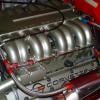Ned.
If you have a 250 amp alternator, then the cable coming off it would need to be the size of a normal battery cable, or close.
You can generally run any sized alternator you want, as its output is a direct result of battery voltage.
The more current you draw, the lower the battery voltage, the more the alternator produces.
It tries to keep the voltage of the system within the regulated range and produces what is needed to do so.
Simplistic terms.
The only thing stopping the alternator running at max will be heat.
Under a bonnet isnt the best spot for it.
But, as with anything electrical running below rated capacity will extend life.
One of my first jobs after I left school was working for what used to be called Civil Aviation Authority many years ago.
They used to design and modify all sorts of stuff for navigation and air safety.
What I learned there was they had a type of inbuilt redundancy in anything they built or repaired.
For example, if a particular component consumed 1/4 watt of power in normal operation, they installed a component capable of taking 1 watt.
4 times design redundancy.
But that is an extreme example.
The major drama I have come across with wiring modifications is the lack of thought going in to the cable size that feeds the parts of the system.
The second major drama is the location of any relays used in the connection of high powered bits.
To be effective, the relay should be as close as possible to whatever it is supplying the power to.
And, most people use the 30 amp square relays for just about everything.
To keep them reliable, you should not go anywhere near 30 amps.
For example.
My old single headlight HZ Panel Van.
I had 90/130W headlights and 150W driving lights.
I had 6 relays for the lights.
3 on each side mounted close to the lights.
I never had a failure, and due to having to do work at night to restore power, they sometimes ran for hours.
Keeping the voltage up to the lamps also increases their life. Far less failures.
Piss poor wiring can cause catastrophic failures.
Years ago I was sitting in the pub and a nice Cortina drove by pumping out loud music.
A couple hours later I got a call to go to a car in fire.
Was the Cortina.
He had picked it up earlier from getting about 15k of sound system installed and was to go to a sound off at Oran Park the next day.
The wiring for the sound system had shorted out causing the fire.
By the time we got there, nothing of the car was salvageable.
Fuses, or circuit breakers are a must.
And must be located properly.
The sole function of a fuse or breaker is to protect the piece of wire it is connected to.
It isnt there to protect the component it supplies.
The fuse needs to be as close to the supply as feasible.
That means near the battery for high powered stuff.
Close to the fuse box/panel in older cars is the next best spot, if taking power that already supplies the fuse box/panel.
The supply to the fuse box/panel is usually already adequately protected, however the cable supplying it may not be sufficient to supply anything additional.
Sorry for the rant, but hope it helps someone thinking about electrics.
Cheers
Rob





 View Garage
View Garage















